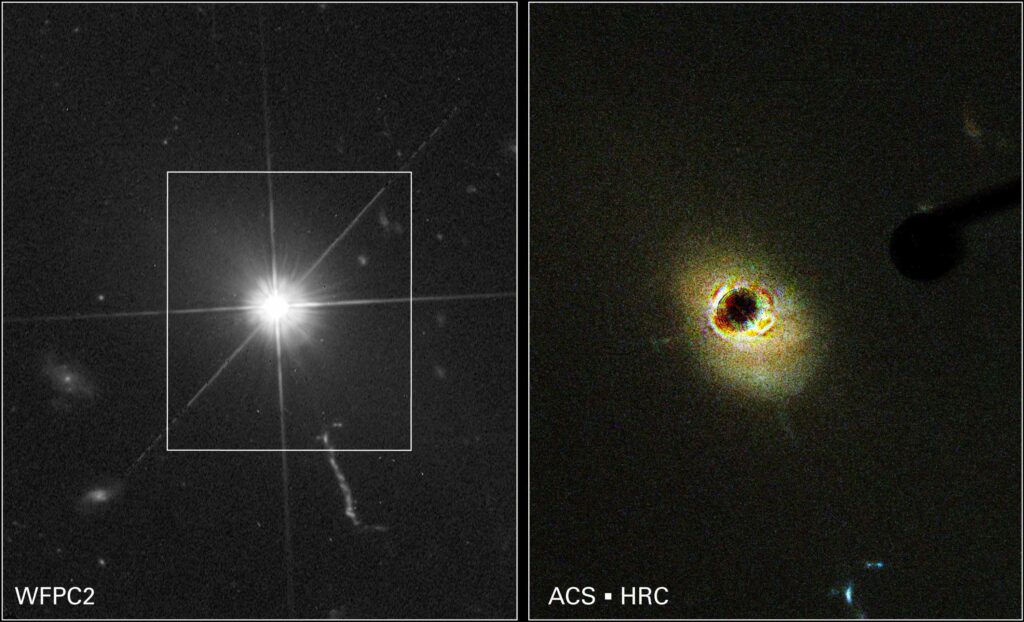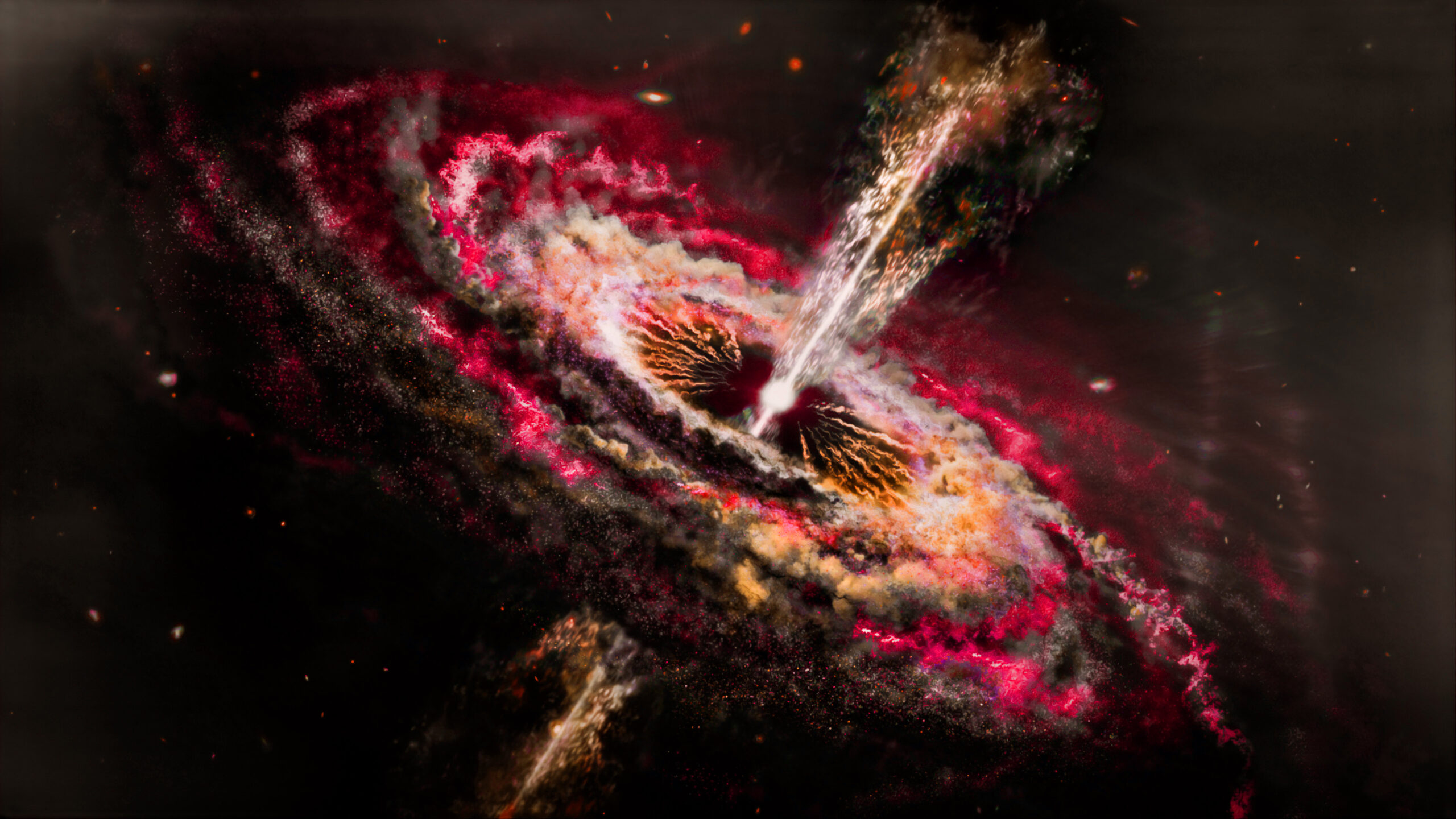Birthing the First Quasars in a Big Bang Universe
Much of my research at the University of Toronto and the California Institute of Technology was focused on quasars. That research, combined with much more that astronomers have conducted since that time, has provided knowledge about quasar activity that carries big bang implications.
Quasars, a contraction of quasi-stellar radio sources, resemble star images in that they first appeared to astronomers as points of light. Their measured distances of hundreds of millions to billions of light-years mean that, by far, they were the brightest objects in the universe. For example, if the quasar 3C 273, which is 2.4 billion light-years away, were placed at a distance of 30 light-years, it would be brighter than the Sun in Earth’s sky. In fact, the quasar brightnesses were so extremely large and variable that astronomers struggled to determine what physical phenomenon could possibly explain their extreme luminosities, energy densities, and both rapid and slow luminosity variations.
Why Quasars Matter
In the late 1960s, astronomers Geoffrey and Margaret Burbidge wrote a book in which they stated that no known physics could explain the observed properties of quasars if, indeed, they were billions of light-years away.1 They concluded, therefore, that quasars “are comparatively nearby although still outside our galaxy.”2 Further, they asserted that the observed properties of quasars, whether they reside at cosmological distances or are relatively nearby, demanded the rejection of big bang creation models. Since several of the big bang characteristics of the universe were predicted in the Bible thousands of years ago,3 much more was and is at stake concerning the properties of quasars than just astrophysics. The truthfulness and predictive power of the Bible concerning what it says about the universe and about the cosmic Creator is also at stake.
During my research stints, I observed that flat spectrum radio galaxies (galaxies showing radio brightnesses at high radio frequencies that are similar to those at low radio frequencies) exhibited radio brightnesses and luminosity variabilities that mimicked those of quasars.4 Therefore, I concluded that quasars likely existed in the cores of giant galaxies where optical telescopes could see the quasars but not their host galaxies. Years later, astronomers, using the next generation of powerful optical telescopes, successfully imaged the host galaxies of several quasars (see figure 1).

At right, a coronagraph is used to block the quasar’s light, making it easier to detect the surrounding host galaxy. Credit: NASA
Many years later, astronomers demonstrated that the extreme luminosities and luminosity variations of quasars and flat spectrum radio sources could be explained by supermassive black holes (SMBHs). These astronomical objects weigh in at a hundred million to several billion times the Sun’s mass and accrete enormous amounts of gas, dust, and stars from their host galaxies. Today, more than a million quasars have been detected. The nearest one is about 600 million light-years away. The most distant is 13.15 billion light-years away. Quasar activity was more common in the distant past. The peak epoch of quasar activity was about 10 billion years ago.5
Quasar Birth Problem
The peak epoch of quasar activity at 10 billion years ago fits big bang creation models well. That date corresponds to when large galaxies would possess huge quantities of gas, dust, and debris to feed the SMBHs in their cores. However, the early birth dates for quasars present a problem. For quasars to exist when the universe is only 650 million years old means that SMBHs that are a hundred million plus times the Sun’s mass must exist at that time.
SMBHs begin to form through merger events between the burnt-out remains of large stars—small black holes and neutron stars. Using gravity wave telescopes, astronomers have detected over two dozen such merger events.6 Only in the cores of galaxies and globular clusters is the stellar density high enough where merger events can cascade. Cascading refers to the aftermath of the merger of two small black holes that, in turn, merge with the aftermath of the merger of two other small black holes and later the merger of now bigger black holes.
The largest existing stars form black holes that top out at 15 times the Sun’s mass. Before stars existed, the universe contained only hydrogen, helium, and a trace amount of lithium. The universe’s first stars formed from this mixture, which permitted much larger stars. These stars could produce black holes as much as 30 times the Sun’s mass.
Beginning with black holes 4–30 times the Sun’s mass, it seems impossible for galaxies to produce SMBHs exceeding one hundred million solar masses in less than 700 million years after the big bang creation event. Some astronomers had speculated that perhaps an early galaxy had evolved exotic conditions that generated an extremely high density of stars in its core. However, it is highly improbable that such conditions would be generated in multiple early galaxies. This improbability is known as the quasar birth problem.
Resolving the Quasar Birth Problem
An international team of five astronomers used the Enzo cosmology code—a sophisticated computer simulation—to accurately model the earliest stages of collapse of the progenitor halos of large galaxies.7 The team determined that strong, cold accretion flows in early galaxies drive violent supersonic turbulence that prevents star formation until dense mass clumps greater than 31,000 solar masses form. The formation of these clumps triggers catastrophic baryon (baryons are protons and neutrons) collapse, which results in the generation of “stars” weighing in at 31,000–40,000 times the Sun’s mass. Such stars never shine. They immediately collapse to form black holes.
The formation of hundreds to thousands of black holes weighing 31,000–40,000 times the Sun’s mass in the cores of large galaxies during the first half billion years of cosmic history provides the necessary seeds to generate SMBHs larger than 100,000,000 solar masses. This formation process is needed to explain the handful of quasars astronomers have discovered that are more distant than 13.1 billion light-years, corresponding to when the universe was less than 700 million years old.
Quasar Birth Problem Solution Implications
The resolution of the quasar birth problem demonstrated by the five astronomers only works for the subset of big bang creation models known as ΛCDM (lambda cold dark matter) big bang models. In these models, the dominant component of the universe is dark energy and the second most dominant component is cold dark matter.
The team’s resolution yields yet another example showing that the more we learn about the universe the more detailed, specific, and accurate the big bang creation model becomes. It also adds to the long list of observational, experimental, and theoretical tests that the big bang creation model has consistently passed. These demonstrations give all of us, both Christians and non-Christians, increasing certainty and confidence that the Bible indeed exhibits accurate predictive power in that it taught at least three fundamental features of the big bang universe thousands of years before astronomers discovered them. Those features include the beginning of the universe, constant laws of physics, and a law of decay that pervades the universe.
This established predictive power of the Bible is strong evidence that the Bible is the inspired, inerrant message from the One who created the universe. Consequently, the Bible’s message is one that no rational human being should ever dismiss or ignore.
Endnotes
- Geoffrey Burbidge and Margaret Burbidge, Quasi-Stellar Objects (San Francisco: W. H. Freeman, 1967).
- Burbidge and Burbidge, Quasi-Stellar Objects, vi.
- Hugh Ross and John Rea, “Big Bang—The Bible Taught It First!” Reasons to Believe, July 1, 2000; Hugh Ross, “Does the Bible Teach Big Bang Cosmology?” Today’s New Reason to Believe (blog), Reasons to Believe, August 26, 2019.
- Hugh Norman Ross, Radio Sources with Low Frequency Cutoffs, Volumes 1 and 2 (Department of Astronomy, David Dunlap Observatory, University of Toronto, PhD Thesis, 1972).
- Maarten Schmidt, Donald P. Schneider, and James E. Gunn, “Spectroscopic CCD Surveys for Quasars at Large Redshift. IV. Evolution of the Luminosity Function from Quasars Detected by Their Lyman-Alpha Emission,” Astronomical Journal 110, no. 1 (July 1995): 68–77, doi:10.1086/117497.
- Hugh Ross, “How Gravitational Waves Help Explain the Universe’s History,” Today’s New Reason to Believe (blog), Reasons to Believe, March 10, 2016; Hugh Ross, “Neutron Star Merger Explains Why We’re Here (Expanded Version), Today’s New Reason to Believe (blog), Reasons to Believe, November 3, 2017.
- M. A. Latif et al., “Turbulent Cold Flows Gave Birth to the First Quasars,” Nature 607 (July 7, 2022): 48–51, doi:10.1038/s41586-022-04813-y.





